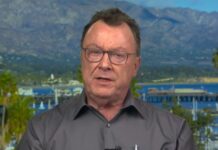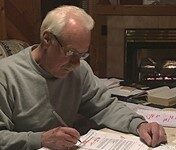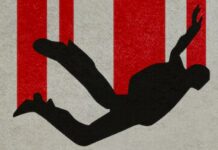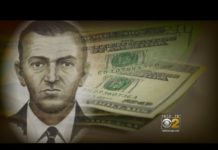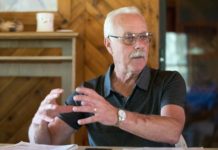Documentary suggests Bankers Hill retiree should be investigated
San Diego Union Tribune
A four-hour documentary that aired on the History Channel this week suggests the infamous airplane hijacker known worldwide as D.B. Cooper may be living out a quiet retirement in a Banker’s Hill condominium.
The program features the work of Ventura County filmmaker Thomas J. Colbert, who says he spent five years with a cold case team of 40 investigators to identify the enigmatic Cooper. Their focus is on Robert W. Rackstraw Sr., now 72, a former Army paratrooper and pilot with forty commendations.
Colbert said his team’s analysis of handwriting samples, DNA, letter trails, and other evidence does not rule out Rackstraw as the one who hijacked Flight 305. He said the possibility should be reviewed by authorities.
“This has been a scab on the FBI for many years, and I have friends there,” said Colbert, a former newsman and police trainer. “I’m hoping they open up the case, but we will see.”
Someone using the name of Dan Cooper — later popularized as D.B. Cooper — bought a one-way Northwest Airlines ticket from Portland to Seattle on Thanksgiving Eve, 1971. He claimed to have a bomb, secured a $200,000 ransom and jumped out of the back of the plane and into the annals of American pop culture.
FBI officials in the Seattle field office issued a statement seven minutes after the documentary broadcast concluded. The agency says the files on NORJAK — as the case is known — have been sent to Washington D.C. for storage and historical value. Nothing short of a break on physical evidence will bring further investigation.
“Every time the FBI assesses additional tips for the NORJAK case, investigative resources and manpower are diverted from programs that more urgently need attention,” the statement said.
Rackstraw did not respond to messages left by The San Diego Union-Tribune on his phone and at his home. When Colbert’s investigators approached Rackstraw in 2013 at his boat shop in Coronado, Rackstraw would only say the evidence was intriguing.
Three years ago, the filmmaker offered Rackstraw $20,000 for movie rights to his story, but only if he turned himself in to the FBI. The former paratrooper mulled the idea for a few moments, twice asking to see the check Colbert wrote out and brought with him.
Then Rackstraw said, “The problem is, I don’t remember a lot of it.”
AN UNCLE NAMED COOPER
In the days immediately following the Northwest hijacking, four taunting letters signed “D.B. Cooper” were mailed to newspapers in Reno, Nev., Portland, Ore. and Vancouver, B.C.
Two of the notes — the first and last — were sent from within 50 miles of Valley Springs, a remote Northern California town in the Sierra Nevada foothills where Rackstraw’s parents lived, and where the Vietnam veteran stayed for the next year and a half, according to Colbert’s research.
These alleged circumstantial connections are among more than 100 pieces of evidence logged by the investigative team.
In another example, the show references a 1960 family vacation to Phoenix, where Rackstraw as a teenager met John “Ed” Cooper, an uncle who was an avid skydiver with hundreds of jumps to his credit.
According to his interviewed sister, Rackstraw became enamored of his skydiving relative on the Arizona vacation, which might explain why the hijacker chose the pseudonym Cooper when booking a flight from Portland to Seattle, a decade-plus later.
Whoever D.B. Cooper was, he fought crushing wind and pounding rain as he made his way down the stairs at the tail end of the Boeing 727, above the thick forests of southern Washington.
“I don’t have a grudge against your airline, miss,” the hijacker told a flight attendant before jumping, according to an FBI transcript. “I just have a grudge.”
With the ransom money tied to his body and a parachute across his back, the man wearing a black suit, trench coat and loafers leaped into the sub-zero night sky.
Experts and amateur sleuths alike have debated for decades whether Cooper survived the unprecedented jump and, if so, whether he made it out of the backwoods wilderness along the Washington-Oregon border.
The new documentary makes the case that Cooper survived, a feat only possible for someone with the right training and experience.
Rackstraw was a decorated Army pilot and paratrooper, trained by Special Forces in deception and survival skills, who knew his way around the kinds of explosives Cooper used to threaten the airliner crew, according to the documentary.
The investigation by Colbert also chronicles other run-ins with the law by Rackstraw, suggesting he was capable of something like the skyjacking. According to Colbert and his team:
— In 1978, he was convicted of check fraud, possessing illegal explosives and stealing a small airplane; he was sentenced to two years in state prison.
— Rackstraw received a two-year probation term in 1992 for damaging property he rented while building an illegal barn to house construction equipment
— In 1999, the FAA suspended his commercial pilot license for providing false statements on an application and failing to report a drunk-driving conviction, as required.
Another enticing piece of Colbert’s evidence, laid out in the History Channel film, is a photo identification of Rackstraw issued by the U.S. Army in 1970. Experts say the black-and-white mug shot bears a striking resemblance to a Cooper sketch released by the FBI in 1971, with nine points of facial match — including close-cropped black hair, odd head shapes, a receding hairline and deep-set eyes.
‘I TOLD EVERYBODY’
Rackstraw was first suspected of being the hijacker in the late 1970s. FBI agents ruled him out in part because flight attendants on the plane said Cooper appeared to be 35 to 45 years old, according to the documentary, when Rackstraw was 28 at the time.
Rackstraw told reporters in 1979 that he “could have been” the infamous hijacker, then quickly recanted.
“I told everybody I was (Cooper),” Rackstraw told Colbert in 2013, before explaining the admission was a stunt.
The filmmakers also interviewed people in the Oregon communities of Corvallis and Astoria, where a charismatic grifter calling himself “Baron Norman de Winter” first appeared in the summer of 1971.
According to the Astoria witnesses – one of whom was elected mayor and another who was a priest for the Catholic Church – de Winter turned up there in July, weeks after Rackstraw was discharged from the Army. Two old newspaper articles documented his time line and con schemes.
De Winter told people he was a Swiss baron vacationing across the West Coast, by way of a small plane he piloted himself. He quickly won their confidence with tales of royalty and a grand chalet, and promised to whisk many of them away on a European holiday come Christmas-time, townspeople told the filmmakers.
Colbert’s investigation uncovered nine Astorians who are convinced de Winter and Rackstraw are the same guy.
De Winter left Astoria in late September, 1971, then showed up in Corvallis a few weeks later, flying a small plane over the area by day and spinning tales of nobility and adventure with drinking buddies by night. He left without notice the day before the hijacking, according to the documentary.
According to Colbert’s investigators, there is near certainty that Cooper, Rackstraw and de Winter are connected. Witnesses say they had similar appearances, they were all pilots, they were never seen separately at the same time, and they were all independently confirmed to be in the same vicinity in the second half of 1971.
“It is statistically impossible for three master criminals to all be operating within 100 miles, let alone three that look alike, have the same flying skills and their travels and letter mailings are all synchronized like whack-a-mole,” the investigative report concludes.
When Rackstraw moved back in with his parents at the end of December in Valley Springs, California, Colbert notes that de Winter and Cooper “were never seen again, and I don’t think that’s a coincidence.”
Colbert plans a news conference in Los Angeles Wednesday to call for the FBI to reopen the case.
Colbert copyrighted the investigation findings and is offering his book, “The Last Master Outlaw,” at dbcooper.com.


